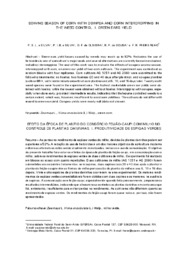Sowing season of corn with cowpea and corn intercropping in the weed control. I. Green ears yield.
Sowing season of corn with cowpea and corn intercropping in the weed control. I. Green ears yield.
Author(s): SILVA, P. S. L. e; SILVA, P. I. B. e; OLIVEIRA, O. F. de; SOUSA, R. P. de; FREIRE FILHO, F. R.
Summary: Green ears yield losses caused by weeds may reach up to 52%. Reducing the use of herbicides is one of agriculture's major goals and several alternatives are currently being investigated, including intercropping. The goal of this work was to evaluate the effects of cowpea sowing season, intercropped with corn, on green ear yield of two corn cultivars. The experiment was carried out as random blocks with four replicates. Corn cultivars AG 1051 and AG 2060 were submitted to the following treatments: no hoeing, two hoeings (20 and 40 days after planting), and cowpea planting (cultivar BR 4, with indeterminate growth) at corn planting and at 5, 10, and 15 days later. Twenty-eight weed species were found in the experiment area. The highest marketable green ear yields were obtained with hoeing, while the lowest were obtained without hoeing. Intercropping with cowpea, especially when done early, provided intermediate results, indicating that the legume controlled weeds to a certain extent, which was, however, insufficient to avoid corn yield loss. The cultivars do not differ with regard to green ear yield. Cowpea yields were nearly null (data not shown).
Publication year: 2006
Types of publication: Paper in annals and proceedings
Unit: Embrapa Mid-North
Keywords: Milho Verde, Vigna Unguiculata, Zea Mays
Observation
Some of Embrapa's publications are published as ePub files. To read them, use or download one of the following free software options to your computer or mobile device. Android: Google Play Books; IOS: iBooks; Windows and Linux: Calibre.
Access other publications
Access the Agricultural Research Database (BDPA) to consult Embrapa's full library collection and records.
Visit Embrapa Bookstore to purchase books and other publications sold by Embrapa.

